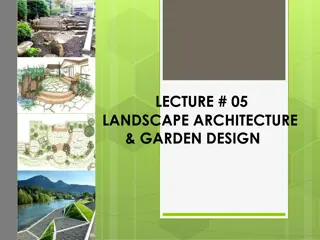The Landscape Design Process: Steps and Considerations
Understand the essential steps in landscape design, including base plan assembly, site analysis, client evaluation, and developing a detailed landscape plan. Discover the importance of accurate architectural drawings and incorporating existing features into your design. Explore the process of drawing plans, selecting plants, and creating a cohesive outdoor space that reflects both aesthetic and functional needs.
Download Presentation

Please find below an Image/Link to download the presentation.
The content on the website is provided AS IS for your information and personal use only. It may not be sold, licensed, or shared on other websites without obtaining consent from the author.If you encounter any issues during the download, it is possible that the publisher has removed the file from their server.
You are allowed to download the files provided on this website for personal or commercial use, subject to the condition that they are used lawfully. All files are the property of their respective owners.
The content on the website is provided AS IS for your information and personal use only. It may not be sold, licensed, or shared on other websites without obtaining consent from the author.
E N D
Presentation Transcript
The Landscape Design Process
thelandscapedesigncenter.com Just as you would not build a house without blueprints, you should not put together a landscape without a design, no matter how small.
Landscape plans are drawn from a birds eye view. Aerial photo and plans drawn for the landscape.
Steps In Design Assemble the Base Plan Conduct a Site Analysis Client Evaluation Assess family needs and desires Develop a Bubble Diagram Locate private, public, service, and utility areas Design Landscape Plan Pencil drawing, then color Plant selection and placement
edis.ifas.ufl.edu. Assembling the Base Plan Obtain architect drawings Plan view drawings (house plans) floor plans Sections side view or cut away slice Perspectives or elevations Contour map or topographic Site or deed map dimensions with proper angles These plans maybe secured from the builder, developer or county or city property records.
edis.ifas.ufl.edu. Assembling the Base Plan The base plan should consist of accurate house placement on the lot accurate lot and house dimensions with window & door placement existing driveways &/or walks (hardscape)
edis.ifas.ufl.edu. Conducting A Site Analysis Features that will stay Existing vegetation tree and shrub condition and placement trees on adjoining property that affect shade patterns Protect existing vegetation during construction Hardscape Permanent features
Conducting A Site Analysis Views to preserve or block Panoramic views--Takes in a wide area, distance from viewer Distant mountain range Valley below Adjoining golf course Concentrated or focused view--particular point Sculpture Unique tree Bed of showy flowers Blocked view--undesirable, needs screened High plant materials Walls fences
edis.ifas.ufl.edu. Conducting A Site Analysis Poor Drainage slope or land elevation changes determines surface water drainage patterns Traffic provide proper access City/County Ordinances
edis.ifas.ufl.edu. Conducting A Site Analysis Noise Levels Identify distractions question neighbors or the property owner Record noise sources like roads, factories, saw mills, etc time of day for peak noise levels Plot the direction and distance of the source Record other distractions--glare or odors
edis.ifas.ufl.edu. Conducting A Site Analysis Utility Placement on poles or underground locate the electrical meter, the air-conditioner unit &water outlets television and telephone cables, water lines and sewage lines, or a septic tank and field line Easements/setback lines Primary architectural features of the house Shape of windows, style, and items that can be repeated in the landscape
edis.ifas.ufl.edu. Conducting A Site Analysis House orientation affects the exposure of various portions of the house to the sun provide shade southeastern exposure- most comfortable spot year- round western slope- hot in summer and cold in winter Soil conditions determines selection and placement of plants Consider soil pH, nutrient and water holding capacity and drainage
edis.ifas.ufl.edu. Conducting A Site Analysis Seasonal wind pattern prevailing winds differ with the area of the state, the season and the time of day existing wind breaks plants and structures on the property or on adjacent property Microclimate conditions in a isolated spot may differ considerably from the conditions in another area of the landscape Other: Snow removal, pile-up
Client Evaluation Landscape Plans for ______________________Residence Address: Phone: Email: Names: Age: M/F: Hobbies: Frequency: Examples of hobbies greenhouse, swimming, rebuilding old cars Frequency--everyday/weekends/some weekends/seldom/seasonal Additional family members expected? (children, grandchildren, aged parents) Do family members have physical limitations?
Outdoor Activities Enjoyed By Family (please note: ask intended future uses past uses, patio, deck, pool, open space for games, etc.) Cooking and dining: Type of cooking Type of entertaining: Number of people Children s play: Specific requirements-- Gardening: Vegetable Garden, Cut Flower Production, Perennial, Annual Pets (please note: indoors, outdoors, confinement Plants (please note: ask what are favorite trees, shrubs, flowers?) Wanted: Avoid: Are family members allergic to specific plants? Privacy issues: Satisfied with current privacy or needs changed What changes?
Landscape Maintenance Sprinkling system available Yes/No Maintenance job Willing to do Hire out Mow grass Prune trees Fertilize & water lawn Rake leaves Mix and spray pesticides Prepare planting areas deadhead Other:
Service Needs Utility Item Need Have Clothes Line Compost Pile Trash Can Storage And Protection Firewood Storage Delivery Access Enclosed Work Area Additional Parking Or Vehicle Storage Other:
Client Considerations Preferences: colors, materials, styles, brands, themes Views: important views into the landscape from major rooms within the house Interior: formal or casual types of d cor original art, crafty, themes, etc Budget: range in mind, one step completion, over time, most important first Time Frame: Changes planned: additions to the home, etc. Other Considerations:
edis.ifas.ufl.edu. Bubble Diagram Establish: Public area Private area Utility area Play area Slow down and think broadly or generally More creative design Think of alternatives Go beyond preconceived notions or ideas
edis.ifas.ufl.edu. Public Area (Entrance area or front yard) 1. Puts the house into an attractive setting Enhance architecture Focus of viewer s attention Recognize value of home 2. Identify & provide access to the point of entry Greatest priority Not complicated Front walk to front door guest parking easy access 3. Includes: lawn, foundation plants, walks, and drives/parking Should not include: cheap plastic animals, recreation equipment, play equipment, swimming pools
edis.ifas.ufl.edu. Private Area (Living Area or backyard) Outside extension of the private living area inside the home Use of plants and/or fences to make private Open space needed for games, etc. Include: Deck or patio, area of open lawn, plants that provide an attractive view may include swimming pool, athletic facilities, barbecue or picnic facilities, trails, view gardens, reflection pools
edis.ifas.ufl.edu. Utility Area (service/work area) Smallest space possible and still functional Screen from private area Locate on driveway side of yard for access May have two or more locations Includes: Clothesline compost bin Firewood fuel tanks garbage containers garden supplies storage Greenhouse pet facilities tool storage utility buildings vegetable gardens workshops
edis.ifas.ufl.edu. Play Area May or may not be part of private area Visible from kitchen Easy access to rear entry door Grass warn under play equipment Use mulch, fine gravel, or sand Includes: swings, slides, sandbox, shade trees
edis.ifas.ufl.edu. Final Design Plan (form composition) Form composition the organization, placement, or relationship of basic shapes so as to produce a naturally and logically connected image Detailed plans for planting and construction show sizes, locations, and quantity of plants and materials drawn to scale
Outdoor Room Concept Outdoor wall Outdoor floor Outdoor ceiling
Outdoor wall Defines the limits or size of the outdoor room Slow or prevent movement in a certain direction Should not be placed in the middle of areas, but sides instead Materials include: shrubs, small trees, ground covers, flowers fencing, masonry
Outdoor floor Provides the surface Materials grass, ground covers, sand, gravel, or water, brick, concrete, patio blocks, tile.
Outdoor ceiling Defines the upper limits of the outdoor room May offer physical protection awning or aluminum covering Shade in summer, drop leaves, warm house in winter
Foundation Plantings: Focalize the main entrance with noticeable plants Compliment architectural style Break long continuous lines of the house Avoid competing elements Select plants Easily be maintained to proper scale with the house Height not to exceed two-thirds the wall at house corners Use taller plants on corners Medium-size shrubs for one-story homes; large shrubs for two story or taller. Use dwarf shrubs or ground covers under windows 4 or less above ground level. Balance the planting with equal foliage mass. Repeat some of the same plants on each end Use variety in plants texture, color, form Mass plants Mature size allowed to touch adjacent plants
Foundation Mistakes Overgrown effect plants too large for rooflines or windows dwarfs home and requires high maintenance to control size Crowded effect large mass of confusion plants too close at time of planting gives instant fullness but plants lose their identity over time Clipped effect plants get a regular haircut maintained with very smooth edge plants loose unique growth habits Unbalanced effect too many plants or larger plants occur on one side or at the end of the planting appears tilted and is out of balance Toy Solider effect Landscape uses one species of landscape plants, often round which are spaced equally with noticeable gaps between plants monotonous, boring and lack creativity Hedge effect plants are trimmed to continuous box shape lacks variety and gives foundation no relief from horizontal lines hedges are used as borders or living fence
Designing a Flower Garden Gates, Christina, Diane Erickson, Shelly Zollinger & Larry Sagers. Temple Square Gardening. Ingland Press 2003.
Steps in Garden designing: Choose a configuration Explosion Sine curve C curve E curve Place skeletal flowers on the ground in a triangular shape with three unequal sides along the curved line Draw line in soil with shovel or use a hose for the line One side of that triangle is then used to form the base of the next triangle of a different size Continue pattern throughout the design until if forms the configuration you have chosen Configurations that don t work Straight lines, concentric circles, checkerboards, zipper patterns
Skeleton Dominance main design principle Shown by plant form, texture, color or position Qualify a plant as skeletal: Strong, tall, vertical (for dominant form) Broad and dramatic (for dominant form) Coarse texture (for dominant texture) Vivid bright blossoms or leaves (for dominant color) 10 to 20 % of flowers used in design
Tendon Positioned after the skeleton plants have been placed Chosen to connect and blend the skeletal flowers, helping to hold together the form of the skeleton Complement skeleton flowers according to principle you choose form might be shorter or less dominant texture might be softer or smaller color might contrast or complement Tendon maintains the configuration line Triangles interlock with the skeleton plant triangles along the configuration line 10 to 20 % of flowers in the design
Flesh More subordinate flowers Scattered in and among the other flowers to complete and fill out the design Place in clusters that form asymmetrical shapes with fractured edges Group together to form clusters around the skeletal and tendon flowers creates a shifting mosaic with the groupings of plants 60-80% of the number of plants
Sparkle Final touch Few special or highly contrasting flowers Odd-numbered groups of three, five or seven Placed randomly
Choosing plants Massing Group alike plants together placed close enough to look like a mass without overcrowding Variety Makes design interesting Vary time of bloom or leaf color, and mature height, spring blooming, fall color Texture Most often associated with leaf size don t use all coarse or fine textured plants Repetition Repeat same plants throughout the design Same plant used on one side should be repeated on the other Symmetrical all same number Asymmetrical not necessary to use same number of plants
Low-Maintenance Landscape Design Planning Even the perfectly designed and installed landscape will fail if maintenance fails Many maintenance problems are designed into landscapes Complex designs usually require more maintenance
Design Keep outlines of grass, decks, sidewalks simple Use curing lines in the borders--more natural Keep lawn out of small wedges and acute angles Avoid acute angles obtuse is allowable If it can be mowed with a riding lawnmower without a lot of trimming, it is a low maintenance design When lines and forms intersect a square, connect them at right angles--90 degrees Landscape the borders of the property especially the rear garden























